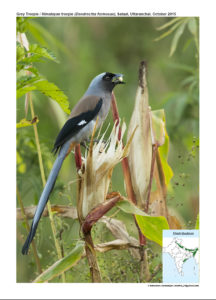Grey Treepie

Grey Treepie Dendrocitta formosae
Etymology:
- Dendrocitta : Greek word Dendron- tree; kitta – magpie.
- Formosae : Latin word for Beautiful
Distribution in India: Widespread resident in India.
Description: Size of 36–40 cm; wt. of 89–121 g. It is a drab brownish-grey Treepie with long, strongly graduated tail, central feather pair somewhat broadening towards tip, short bill with strong curve on culmen and cutting edges. The nominate race has forehead and side of crown as blackish-brown, blackest on forecrown and above eye, shading lighter on rear ear-coverts and to breast, remainder of crown and nape are light grey, becoming brownish on mantle, The upperparts are dark brown, lower rump and uppertail-coverts are greyish-white; upperwing is black, white bases on primaries (white patch); tail is black, basal third of central feather pair is pale grey. The breast is brownish-grey, shading paler on lower underparts, undertail-coverts are chestnut; iris is red or reddish-brown; bill and legs are blackish-grey. Both the sexes are similar. The juvenile is more uniformly grey-brown, black areas of wings are browner than adult, tail with narrow rusty tips.
Habitat: It is found in deciduous montane woodland of all kinds, from tropical evergreen forest in foothills to oak-rhododendron forest at higher elevations. It is found from 800 m and 2300 m.
Food habits: It eats invertebrates and their larvae, such as grasshoppers, beetles , moths , spiders and centipedes, some small vertebrates, including lizards and small birds, and eggs and nestlings of small birds. It also eats variety of fruits and seeds and nectar from flowering trees and shrubs .It scavenges around villages for kitchen waste. It also raids orchards for cultivated fruits, like figs and mulberries. It forages in pairs or small family groups. It follows mixed-species groups of larger forest birds, like laughingthrushes for insects flushed by the flock moving through undergrowth. It hovers briefly and clumsily in canopy to reach fruits. Spends most of time in trees, but often feeds on ground, hopping about, with raised tail; often in open on terraced hillsides as it feeds on fallen grain.
Breeding habits: Theybreed in Apr–Jul in North India and Myanmar. They are solitary breeders. The nest is built by both sexes. The nest is a flimsy cup of thin sticks, shallow cup lined with rootlets and other soft plant material, placed above ground inside canopy of small tree or shrub or in stand of bamboo, sometimes virtually on ground. They lay a clutch of 3–5 eggs. The incubation is shared by both sexes. Both parents feed the young.
.